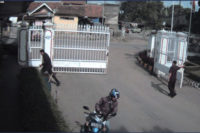The development and deployment of video surveillance technologies continues to gain momentum, and keeping pace with this success are the powerful advances being made in camera imaging. From megapixel technology to improved light sensitivity to digitally enhanced functionality, today’s video surveillance cameras can help ensure that users are able to capture the images they need to successfully identify individuals and review events.
360 as an Option to Mechanical Pan/Tilt
Effectively capturing the needed images from an entire location with one camera has, been one of the shortfalls of video surveillance imaging technology. While pan/tilt functionality can accomplish much of this requirement, it has its drawbacks. These include missing some of the activity because of pan speed or tilt angle or because the camera is not facing the action at a critical time and a high degree of accuracy is needed for viewing objects at a long distance.
These obstacles have been supplemented with the advent of more advanced 360° imaging technology. Panoramic or 360° viewing promises near complete situational coverage with the added advantage of forensic pan/tilt/zoom functionality. For example, with fixed cameras, even when utilizing increased numbers of cameras per site vulnerable blind spots remain in every installation. In these instances a 360° camera can complement the overall video surveillance system by helping to eliminate many of these potentially susceptible weak areas. And with electronic pan/tilt/zoom capability, viewing can be enhanced in both live and playback modes. The applications for 360° coverage are nearly limitless and the cameras can be found in casinos, schools, airports, cruise ships, military bases, amusement parks and other locations where there is heavy or constant pedestrian traffic.
What Makes it Go Round
The technology behind 360° images varies from manufacturer to manufacturer and some of the more prevalent solutions include highly specialized wide angle or fisheye-type lenses supported by software re-mapping that seams the images from a single camera into one. Similarly, images from multiple cameras can be woven together with state-of-the-art video stitching technology to form one seamless picture with independent perspective-corrected views for each camera. Technology shared by all of the 360° cameras are megapixel chips for high resolution images and IP-based operation for system convenience and integration. Many of the camera vendors have also added PoE (Power over Ethernet) functionality to the cameras in addition to traditional features such as alarm inputs. On-board intelligence and software applications also permit the creation of detection zones that will provide alerts if an area is breached, while other software applications allow operators to tag a target and follow it, automatically panning and tilting as needed.
As with standard video surveillance cameras, viewing images from 360° cameras can be done live or on playback. But, unlike standard video surveillance cameras, viewing can be in panoramic or multi-view screen mode where each camera can be viewed and controlled independently. When used in playback, the electronic pan/tilt/zoom offers forensic detail that can often facilitate faster and more decisive action.
The Pros and Cons
There are multiple advantages to a 360° camera deployment – complete field-of-view, built-in video analytics, separate flat screen pan/tilt/zoom views, sharp and defined details, forensic viewing of panoramic images, no moving parts to wear out or fail, reduced number of cameras and infrastructure needed to monitor a scene, including reduced personnel etc.
There are however a few disadvantages to 360° cameras. As with any camera, 360° cameras perform better in well-lit scenes; the more pixels, the more light that is needed. This restriction can limit the camera’s use in outdoor applications or in those areas with limited/low lighting such as parking garages. Cost is another inhibiting factor when considering the addition of 360° cameras to a system. While it is true that in some situations a single 360° camera can reasonably be substituted for up to four fixed cameras, the original investment of the 360° camera may still exceed the cost of the comparable fixed cameras, even complete with all the inherent costs of investment, installation and maintenance. Because of the size of transmitted video packet, storage requirements may also be affected or a dedicated network may be required, adding to the overall expenditure.
Given the appropriate situation though, a 360° camera can often be the better choice when designing or upgrading a video surveillance system. It’s a powerful technology that will only grow in operational value.



